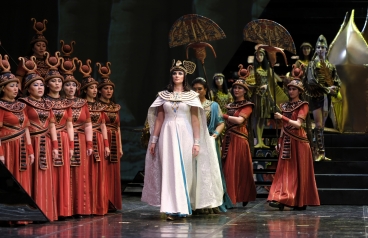AIDA

Libretto by Antonio Ghislanzoni, written by Egyptologist François Auguste Ferdinand Mariette
commissioned by the Egyptian khedive Ismail Pasha for the Cairo Opera House
"AIDA"
Opera in 4 acts
The performance has three intermissions.
Duration: 3 hours 30 minutes
Age category: 10+
The opera is performed in Italian, accompanied by synchronized subtitles in Russian and Kazakh
Characters:
Pharaoh, Egyptian king (bass)
Ramfis, high priest (bass)
Radames, young chief of the palace guards (tenor)
Amneris, Pharaoh's Daughter (mezzo-soprano)
Aida, an Ethiopian slave (soprano)
Amonasro, Ethiopian king, father of Aida (baritone)
Messenger (tenor)
Priestess (soprano)
Priests, priestesses, courtiers, soldiers, servants, slaves and captives Ethiopians, the Egyptian people
Symphony orchestra, chorus and ballet of the Abay Kazakh National Opera and Ballet Theater
Production team:
Production-conductor - Yerbolat Akhmedyarov, Honored Figure of the Republic of Kazakhstan, chief conductor of Abay KazNTOB
Conductor - Nurlan Zharasov, Honored Figure of the Republic of Kazakhstan
Stage director - Laylim Imangazina, Honored Figure of the Republic of Kazakhstan
Production designer - Vyacheslav Okunev, People's Artist of the Russian Federation, laureate of State Prizes (St. Petersburg)
Multimedia artist - Victoria Zlotnikova (Russia)
Choreography - Mintai Tleubaev, Honored Artist of the Kazakh SSR
Chief Choirmaster - Aliya Temirbekova
Artistic director of the ballet troupe - Gulzhan Tutkibaeva, People's Artist of the Republic of Kazakhstan
History
Giuseppe Verdi is the greatest composer. An amazing providence chose him to become a symbol of the unification of Italy and a composer, without whom the opera would never be as we know it today.
His operas, which have become the pinnacle of not only Italian, but of the entire world opera, breathe by sincerity and inspiration, they have entered the treasury of world opera art. Centuries later, exactly Verdi's operas there are the most popular and most performed on the stages of the best musical theaters.
The composer has composed twenty-six operas and one requiem. The best works are «Un ballo in maschera», «Il trovatore», «Rigoletto» and «La Traviata». However, according to critics and experts, the pinnacle of Verdi's work is his latest operas «Othello», «Aida» and «Falstaff».
Opera «Aida» can be called one of the best in the history of music. Everything is beautiful in it: colorful music, vivid images and an unusual plot, based on real historical events, which gives it a special poignancy. The creation of «Aida» stems from a proposal by the Egyptian government to write an opera for a new opera house in Cairo to commemorate the opening of the Suez Canal. The script was written by the famous Egyptologist - François Auguste Ferdinand Mariette, who took as the basis of the plot a legend, which he read after decrypting an ancient papyrus found in one of the tombs. Stiry talked about the long struggle of the pharaohs against Nubia (Ethiopia). Mariette's friend - Camille du Locle wrote a prosaic presentation of the plot, and the poet Antonio Ghislanzoni wrote an Italian libretto in verse. Verdi actively participated in the creation of the libretto, he himself gave extremely detailed instructions regarding plot twists and even wrote some poetic lines. Exactly Verdi introduced the theme of loyalty to the homeland and the conflict between duty and feeling (Radames, Aida), as well as the idea of condemning wars of conquest and enmity between nations.
Work on the opera lasted two years. As for the music, it was written in four months.
The premiere of «Aida» took place on December 24, 1871 in Cairo.
Since then, Verdi's immortal creation has adorned the repertoire of all the world's leading opera houses, causing the audience to delight.
On the stage of the Abay Kazakh National Opera and Ballet Theater, the opera «Aida» was staged by the Honored Art Figure of the RSFSR - Boris Ryabikin (1970) and People's Artist of Uzbekistan and Azerbaijan - Firudin Safarov (2001). Scenography by Gulfayrus Ismailova, Honored Art Figure of the Kazakh SSR, People's Artist of Kazakhstan.












